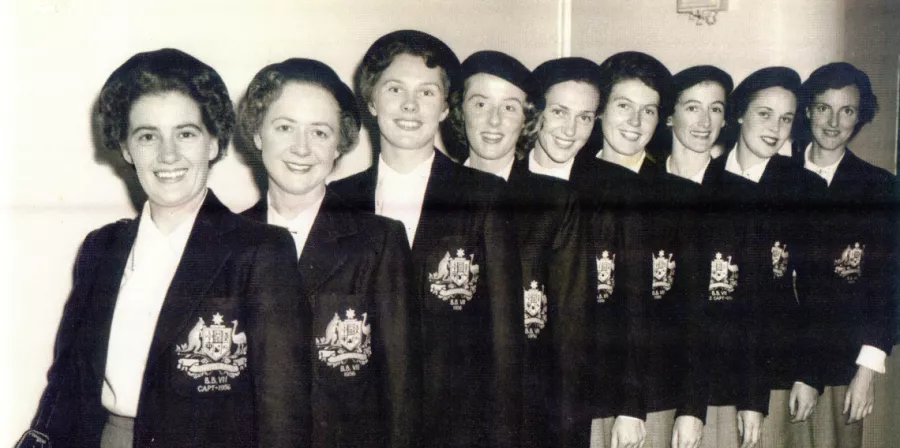Despite the disruption and deprivations of the Second World War, it did not take long for netball (then known as women’s basketball) to regain its momentum. Australia was on the cusp of an era of economic growth and post-war prosperity, spurred as it was by a mantra of ‘populate or perish’ that helped to foster a baby boom across the nation.
In fact, by the early 1950s, netball was possibly at its peak in Victoria, with the numbers of girls and women involved in regional, city and school competitions on the increase. For instance, at the opening of the 1950 day-time season, 500 girls ‘in colourful uniforms’ marched around the “Women’s Sports Oval” at Royal Park, and it was noted that more than 700 players regularly participated in the night competition. In this context, the “Age” newspaper praised officials for the manner in which they provided facilities and organised competitions “for the many thousands of girls who name this game as their favourite sport”.
The senior Victorian team also showed they meant business at the start of the new decade, travelling to Perth in August 1950 and winning the interstate carnival, as well as meeting political dignitaries such as the Federal Opposition Leader.

Back: …, …, Joan Taylor, Jan MacDonald, Patricia Doherty
Front: Valerie Taylor, W. McKenzie, Jean Cowan, Laura Hornig, …
Unidentified: M. Tomlins, H. Darson, F. Edgar

Several members of the Victorian team (as captioned) in Perth, meeting Opposition Leader Ben Chifley [Courtesy of Jean Cowan. Note that other unpublished images of this meeting are also part of the Edith Hull Collection, Netball Victoria].
A “changing of the guard” also marked this dynamic period, with foundation president Louise C. Mills (affectionately known as the “mother of Victorian women’s sport”), passing away in 1952. Long-serving player and administrator Edith Hull also stepped aside from her role as president, having held this office between 1934 and 1938, and 1947 and 1953). Hull was also a significant contributor to the war effort, having joined the Australian Women’s Land Army (AWLA) in 1942, and then later leading AWLA members in a Victory March after hostilities had ended. She later became the founding Vice-President of the AWLA Ex-Members’ Association.

Louise C. Mills (left) and Edith Hull, pictured together in Sydney on their way to the interstate carnival in Brisbane in 1934 [Courtesy of Netball Victoria].
The 1952 VWBBA premier team had a strong line-up, and included both state and national players, as well as past and future internationals.

Members of the 1952 VWBBA AA Premier team (as captioned) [Courtesy of Netball Victoria].
Certainly the highlight of the decade in terms of netball’s international development was the very successful Australian tour of the United Kingdom (UK) in 1956. Two Victorians were selected in the squad, namely the diminutive captain and wing attack, Patricia Doherty (later McCarthy), aged 24, and Jan MacDonald, aged 21.

Members of the 1956 touring Australian squad, including Victorians Patricia Doherty (first on the left), and Jan MacDonald (third on the left) [Courtesy of Netball Victoria].
Importantly, VWBBA president at the time, Lorna McConchie, was also appointed the manager and coach of the tour, and it was her meticulous planning and organisational skills, along with her diplomacy, that ensured the success of the arduous trip of more than four months, which also included a stopover in Ceylon (Sri Lanka) and a match against their local team.
Australia won 64 of 67 games played in the UK under their local rules, but the key outcome was achieved later when there was widespread agreement that a universal set of rules should be adopted. This consensus eventually led to the formation of the International Federation of Netball Associations, and much greater collaboration and cooperation between netball-playing nations.

The opening paragraphs of Lorna McConchie’s lengthy hand-written report on the first Australian netball team to tour the UK. Lorna was the coach and team manager [Courtesy of Netball Victoria].
Perhaps the saddest incident from the 1950s was the death of Laura Hornig. She represented Victoria (1938, 1945-1947, 1949-1950) and Australia (making her debut on 14 August 1948), and was awarded an ‘AA’ umpire’s badge in 1951. Laura tragically died after contracting a strain of Asian influenza following the national carnival in Adelaide in 1957. Some of her memorabilia was later gifted to Netball Victoria, helping to form an integral part of the Edith Hull Collection. One of several precious items is a detailed scrapbook of her participation in the Australian tour of New Zealand.

Laura Hornig (pictured second from bottom left) with the Australian squad who toured New Zealand in 1948 [Courtesy of Jean Cowan, Edith Hull Collection, Netball Victoria].
To round out the decade, it is worth recording that the inaugural meeting of the Victorian Women’s Ex/Basket Ballers’ Association was hosted by the Young Women’s Christian Association on 27 September 1959. The foundation president was Mrs Elsie Ferres, and the foundation secretary/treasurer was Mrs Pat Martin. This group is currently known as the Victorian Past and Present Netballers’ Association (VPNNA). It meets regularly and produces newsletters based on contributions from members.

Current letterhead of the VPNNA [Courtesy of the VPPNA and Netball Victoria].
Curatorial Notes:
Anyone with information related to netball heritage items from the 1950s, particularly memorabilia associated with state or national teams, should contact Netball Victoria at communications@netballvic.com.au.
